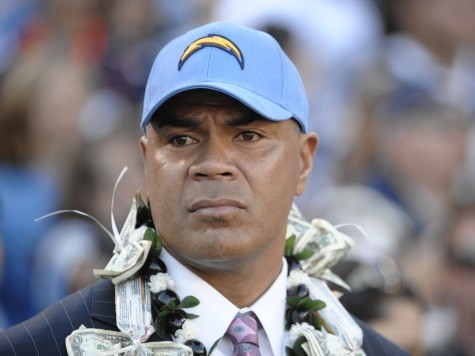The family of Junior Seau has opted out of the NFL concussion lawsuit settlement. The deal grants the survivors of victims of chronic traumatic encephalopathy, a degenerative brain disease that Boston University researchers report finding in Junior Seau upon autopsy, $4 million. They plan to move forward with a wrongful-death suit against the league.
“The family want[s] to know why this settlement seems designed for expediency for the NFL and to ensure that information doesn’t come out,” attorney Steven Strauss told ESPN‘s Outside the Lines. “And the Seau family wants the truth to come out. Since this litigation started, there hasn’t been one document produced, there hasn’t been one deposition taken. It seems very clearly designed to nip this in the bud and not have the truth come out, and that’s not acceptable to the Seau family, and it’s not acceptable to Junior’s legacy.”
The truth coming out, presumably, would involve Junior Seau and not just the NFL.
The San Diego Union Tribune‘s Jill Lieber Steeg characterized Junior Seau’s life as one “marked by depression, drinking, prescription drugs, gambling, financial woes, sexual escapades and strained relationships.” In other words, the maladies and pathologies that cause men in the stands to take their own lives also afflicted the linebacker they cheered for on the field, too.
According to friends, Seau drank five or six nights a week. “Unable to sleep more than three or four hours a night dating to his first years with Chargers in the early to mid-1990s,” Lieber Steeg writes, “Seau often relied on a variety of prescription and nonprescription sleeping aids, including zolpidem, which belongs to a class of medications called sedation-hypnotics with the brand name Ambien. [Ex-wife] Gina said Seau used Ambien, Nyquil and antihistamines to sleep. He never was medically treated for his inability to sleep or his long-term insomnia.”
Seau, who played twenty seasons in the National Football League, couldn’t quite say goodbye to the gridiron and couldn’t quite say hello to opportunities in retirement. The cable channel Versus cancelled a Seau-hosted program after ten episodes. The analyst opportunities that came to former teammates Rodney Harrison and Tedy Bruschi didn’t come to him.
Divorced, Seau ran through a string of twentysomething girlfriends. One had accused him of domestic violence; many had accused him of infidelity. The former San Diego Charger’s kids suffered through strained relationships with their often-absentee dad. The problems resulted in confrontations and estrangement prior to the future Hall of Famer putting a .357 Magnum to his chest.
Seau’s finances were as messy as his family. A week before his death, the Bellagio called in the $400,000 they had floated him at the tables. He owed Caesar’s Palace even more. During Seau’s earnings peak in the NFL, his ex-wife claimed $87,500 a month in alimony and his kids claimed $40,000 a month in child support. Seau lost a million in investments in Ruby Tuesdays restaurants. Seau’s, his more upscale steakhouse, died just weeks after its namesake did. A financial advisor had years earlier swindled him out of seven figures. Junior Seau saw millions of reasons to kill himself.
But critics of America’s game see just one, football, the sole activity in which we watched Junior Seau participate.
If tackle football caused suicide, then one would expect that the rate of men killing themselves in the United States, where nearly four million boys play the game, would dwarf other industrialized nations and that the rate of men killing themselves in the National Football League would dwarf the rate of men killing themselves in the surrounding society and in other professional sports.
Yet, the U.S. suicide rate trails Russia, France, South Africa, Japan, and other countries where football means a kicking rather than a colliding sport. When the National Institute for Occupational Safety and Health (NIOSH) looked at the mortality of every athlete who competed in the NFL for five or more seasons between 1959 and 1988, the scientists discovered nine suicides compared to the 22 found among the comparable societal peer group. In conducting research for The War on Football: Saving America’s Game, I discovered that the rate of suicide among Major League Baseball players eclipsed the rate among National Football League players.
When does the media meme about the deadly dangers of the suicide squeeze replace the one about football hits?
The Seau family attorney says he “wants the truth to come out.” Yet, the litigation he involves himself in bases itself in part on the notion that football players kill themselves at elevated rates, a notion thoroughly debunked by Breitbart Sports in a January series that resulted in the organization responsible for a widely-cited statistic that NFL players kill themselves at six-times the national rate to retract. The reality that NFL players kill themselves at less than half of the rate of men in society doesn’t fit with the media narrative or this litigation.
There’s a truth that the New York Times, Washington Post, Boston Globe, Time, and other media outlets pushing the discredited statistic that NFL players kill themselves at six times the national average don’t want to come out. Football–running and jumping, tackling and wrestling, training and diet, throwing and catching–is good for you.
Chemical abuse, gambling, divorce, health woes, and financial problems all stand as risk factors for suicide. Football does not.
Daniel J. Flynn, the author of The War on Football: Saving America’s Game (Regnery, 2013), edits Breitbart Sports.

COMMENTS
Please let us know if you're having issues with commenting.